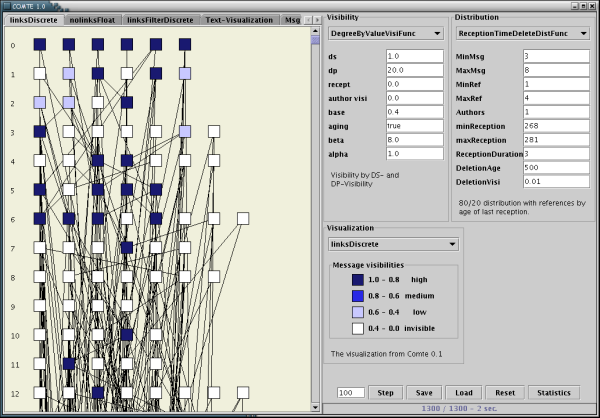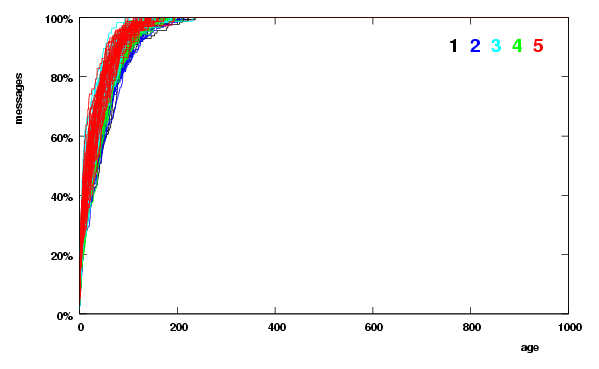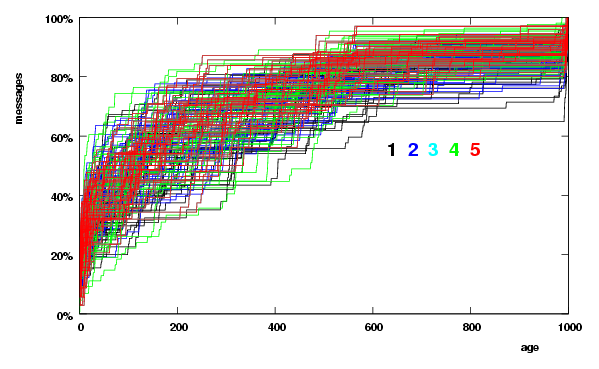Communication Between Process and Structure: Modelling and Simulating Message Reference Networks with COM/TE
Journal of Artificial Societies and Social Simulation
vol. 10, no. 1
<https://www.jasss.org/10/1/9.html>
For information about citing this article, click here
Received: 20-Jan-2006 Accepted: 18-Jul-2006 Published: 31-Jan-2007
 Abstract
Abstract

|
| Figure 1. COM/TE, the COM Test Environment for analysing and simulating communication processes. The frame to the left displays the message reference network (in this view messages created in the last 12 time steps are shown, with the newest messages on top). Note that in the simulation tool the network grows from bottom to top, with the oldest messages at the bottom |
|
|
(1) |

|
(2) |
With growing numbers of messages, the probability of a single message attracting a new reference (its relative social visibility) decreases, even if its present visibility is high, because the number of visible messages increases Σvist(m). To ensure that most messages have a visibility close to zero and only a few stand out, we modify the visibility function by introducing a parameter β to increase contrast:
|
|
(3) |
The values of b, δin and δout are chosen small enough to keep the value in parenthesis below 1, so β>1 will do the trick.[8]

|
(4) |
with α determining the degree of ageing. By ageing, the visibility of messages not being supported by links from other messages decreases in time. This models the idea that if a document is not noticed by more recent documents, it seems to be unimportant for the current discussion. Here, α simply controls the "speed" of ageing.

|
(5) |
with vist(M)=Σvist(m), In(m) the set of messages referencing m and Out(m) the set of messages being referenced by m.

|
| Figure 2. Modernist, Classicist and Historicist patterns. The most visible messages are clustered in the last few time steps (modernist, left network), in the oldest time step (historicist, right network) or are fairly distributed (classicist, middle network) |

|
| Figure 3. Distribution of visible messages. The summed percentage of visible messages up to a certain age is shown. H indicates the historicist pattern with no visible messages of low age. M, in contrast, indicates the modernist pattern and in between, several classicist patterns with visible messages distributed over the whole length are shown |
| Table 1: Parameter sets | |||
| M | C | H | |
| δIn | 20.000 | 1000.000 | 60.000 |
| δOut | 1.000 | 0.500 | 0.002 |
| b | 0.400 | 0.023 | 0.700 |
| α | 1.000 | 1.150 | 1.000 |
| β | 8.000 | 8.000 | 8.000 |

|
| Figure 4. Distribution of visible messages. Three different sets of parameters with 40 runs each over 1000 generations resembling the modernist, classicist and historicist patterns |
| Table 2: Media forms | |||
| Reference/reception ratio | |||
| High c∈{268,…281} | Low c∈{27,28} | ||
| Message persistence | High tdel=500, visdel=0.01 | (i) Archive-based communication | (ii) Scientific communication |
| Low tdel=50, visdel=0.39 | (iii) Mass media communication | (iv) Face-to-face communication | |
| Table 3: Average of 40 runs with 1000 generations | ||||||
| Standard | high r/r-ratio, high persistence | low r/r-ratio, high persistence | high r/r-ratio, low persistence | low r/r-ratio, low persistence | ||
| number of messages | Modernist | 5492 | 2748.9 | 2750.9 | 313.8 | 286.3 |
| Historicist | 5498.9 | 5485.9 | 5500.9 | 346.6 | 303.4 | |
| Classicist | 5502.3 | 2770.3 | 2759.2 | 306.2 | 294.8 | |
| number of visible messages ≥ 0.4 | Modernist | 123.9 | 119.4 | 68.4 | 121.3 | 67.6 |
| Historicist | 88.9 | 64.7 | 21.6 | 84.3 | 38.2 | |
| Classicist | 51.7 | 50.9 | 35 | 51.2 | 36.4 | |
| average visibility | Modernist | 0.023 | 0.044 | 0.025 | 0.381 | 0.232 |
| Historicist | 0.079 | 0.069 | 0.061 | 0.278 | 0.173 | |
| Classicist | 0.009 | 0.018 | 0.012 | 0.165 | 0.122 | |
| number of references | Modernist | 13711 | 6119.9 | 4455.6 | 594.8 | 383.3 |
| Historicist | 13726.9 | 7439.4 | 2523.2 | 685.7 | 435.7 | |
| Classicist | 13765.9 | 5858.5 | 5406.6 | 699.4 | 594.5 | |
| 1. Quartile | Modernist | 7.1 | 6.9 | 4.4 | 6.8 | 4.1 |
| Historicist | 936.5 | 967.8 | 990 | 70.9 | 77.7 | |
| Classicist | 22.8 | 13.1 | 15.6 | 25.2 | 14.8 | |
| 2. Quartile | Modernist | 27.4 | 27 | 19.2 | 26.2 | 19.5 |
| Historicist | 982.1 | 985.6 | 995.4 | 173.1 | 149.2 | |
| Classicist | 166.3 | 127.3 | 126.8 | 134.9 | 105.1 | |
| 3. Quartile | Modernist | 61.2 | 61 | 49 | 56.6 | 46.5 |
| Historicist | 993.4 | 994.3 | 998.2 | 347.6 | 285.5 | |
| Classicist | 497.9 | 442.8 | 390.1 | 430.7 | 324.8 | |
| rounds between first and last visible message | Modernist | 174.5 | 168.9 | 141.9 | 162.1 | 141.4 |
| Historicist | 987.5 | 652.5 | 52.7 | 922.3 | 641.1 | |
| Classicist | 1000 | 1000 | 999.9 | 999.6 | 999.9 | |
| 1 | 2 | 3 | 4 | 5 | ||

|
| Figure 5. Distribution of visible messages for the modernist style (M) parameter set. Colours correspond to the different parameters for reception and deletion (see Table 3) |

|
| Figure 6. Distribution of visible messages for the classicist style (C) parameter set. Colours correspond to the different parameters for reception and deletion (see Table 3) |

|
| Figure 7. Distribution of visible messages for the historicist style (H) parameter set. Colours correspond to the different parameters for reception and deletion (see Table 3) |
2 The original meaning of "inception" is "to begin", "to enact", or "to found". Here, in our theoretical context, inception is the beginning of something which is expected to happen afterwards: it denotes a reception as the next complementary operation needed to continue the communication process.
3 This is an example of social visibility in the process of scientific communication: both publications appeared in the same journal. The paper by DeSolla Price was not cited by Barabási and Albert, thus we conclude that it was not visible for the follow-up paper nor for the current scientific discourse.
4 These "translations" of social visibility have to be used with caution because they inherit value-judgments (for example, credibility).
5 In the simulation design currently being used, the number of receptions a message receives does not influence its visibility directly — receptions only keep the message accessible for later references.
6 In COM/TE, we limit the visibility of a message to the interval [0,1], greater values are cut off. In the following sections any function calculating the visibility of a message vis(m)=f(m) has to be read as vis(m)=min{1,f(m)}. This is for the sake of readability.
7 In many communication processes δin>δout reflects the fact that the references a message obtains have a greater impact on its visibility than the references it establishes.
8 Otherwise, vis(m) will be cut off anyway.
9 In our setting visthreshold is 0.4: every message with a visibility smaller than 0.4 is counted as being invisible.
10 "Interactivity is not a characteristic of the medium. It is a process-related construct about communication. It is the extent to which messages in a sequence relate to each other, and especially the extent to which later messages recount the relatedness of earlier messages" (Rafaeli and Sudweeks 1997).
11 The distribution is shown in percentage terms, therefore changes in density of visible messages do not show up in the figures but only in the statistical values.
12 For an application of COM at the micro level of Multiagent Systems (MAS) cf. Stein and Schlieder 2005.
ALBRECHT, S. and LÜBCKE, M. and MALSCH, T. and SCHLIEDER, C. (2005) Scalability and the Social Dynamics of Communication. On Comparing SNA and COM as Models of Communication Networks. In Fischer, K and Florian, M (Eds.), Socionics. Its Contributions to the Scalability of Complex Social Systems. Berlin, Heidelberg, New York: Springer.
BARABÁSI, A-L., ALBERT, R. (1999) The Emergence of Scaling in Random Networks, Science, 286:509-512.
BARABÁSI, A-L. (2003) Linked. How Everything is Connected to Everything Else and What It Means for Business, Science, and Everyday Life. With a New Afterword. New York, London: Plume. Penguin Group.
BIHANIC, D. (2003) A Complete System of Tridimensional Graphical Representation of Information: "Crystal Hy-MapTM". Paper presented at the COSIGN 2003.
BRIN, S. and PAGE. L. (1998) The anatomy of a large-scale hypertextual Web search engine. Computer Networks and ISDN Systems, 30 (1-7). pp. 107-117.
BUZING, P. C., EIBEN, A. E. and SCHUT, M. C. (2005) Emerging communication and cooperation in evolving agent societies, Journal of Artificial Societies and Social Simulation, vol. 8, no. 1. https://www.jasss.org/8/1/2.html
DESOLLA Price, D. J. (1965) Networks of Scientific Papers: The pattern of bibliographic references indicates the nature of the scientific research front, Science, 149(3683), pp. 510-515.
EIJK, R.M.v., HUGET, M.-P., DIGNUM, F. (Eds.) (2005) Agent Communication: International Workshop on Agent Communication, AC 2004, LNCS 3396, Berlin: Springer.
EPSTEIN, J. and AXTELL, R. (1996) Growing Artificial Societies: Social Science From The Bottom Up. Brookings Institute Press.
HEWITT, C (1991) Open Information Systems Semantics for Distributed Artificial Intelligence, Artificial Intelligence 47, pp. 79-106).
KERNE, A. and SUNDARAM, V. (2003) A Recombinant Information Space. Paper presented at the COSIGN 2003.
LESK, M (1997) Practical Digital Libraries. Book, Bytes, and Bucks. San Francisco, CA: Morgan Kaufmann.
LUEG, C. (2000) Supporting Social Navigation in Usenet Newsgroups. In: Turner, T (ed.): CHI 2000 Conference Proceedings. Conference on Human Factors in Computing Systems. New York: ACM-Press.
LUHMANN, N. (1984) Soziale Systeme. Grundriss einer allgemeinen Theorie. Frankfurt am Main: Suhrkamp.
MALSCH, T. and SCHLIEDER, C. (2004) "Communication without Agents? From Agent-Oriented to Communication-Oriented Modelling". In Lindemann, G, Mold, D and Paolucci M (Eds.), Regulated Agent-Based Social Systems. First International Workshop, RASTA 2002, Bologna, Italy, June 2002. Revised Selected and Invited Papers. Berlin, Heidelberg, New York: Springer, pp. 113-133.
MALSCH, T. (2005) Kommunikationsanschlüsse. Zur soziologischen Differenz von realer und künstlicher Sozialität. Wiesbaden: Verlag für Sozialwissenschaften/GWV Fachverlage GmbH.
MEAD, G. H. (1934/1996) Mind, Self and Society from the Standpoint of a Social Behaviorist. Chicago: University of Chicago Press.
PAGE, L. and BRIN, S. and MOTWANI, R. and WINOGRAD, T (1998) The PageRank Citation Ranking: Bringing Order to the Web , Technical Report, Stanford Digital Library Technologies Project.
PETRIC, M. and TOMIC-KOLUDROVIC, I. and MITROVIC, I. (2001). A Missing Link: The Role of Semiotics in Multiagent Environments. Paper presented at the COSIGN 2001.
PINSKI, G. and NARIN, F. (1976) Citation Influence for Journal Aggregates of Scientific Publications: Theory, with Application to the Literature of Physics. Information Processing and Management, 12(5), pp. 297-312.
RAFAELI, S. and SUDWEEKS, F. (1997) Networked Interactivity. Journal of Computer-Mediated Communication vol. 2, no. 4 http://jcmc.indiana.edu/vol2/issue4/rafaeli.sudweeks.html.
SACK, W. (2000) Conversation Map: A Content Based Conversation Map. In: Lieberman, H (eds): IUI 2000 International Conference on Intelligent User Interfaces (January 9-12, 2000). New Orleans: ACM-Press, pp. 233-240.
SMITH, M. (1999) Invisible crowds in cyberspace. Mapping the social structure of the Usenet. In: Smith M, and Kollock P (ed): Communities in Cyberspace. London: Routledge Press, pp. 195-219.
SMITH, M. (2003) Measures and Maps of Usenet. In: Fisher, D, Lueg, C (eds.): From Usenet to CoWebs. Interacting with Social Information Spaces. London: Springer, pp. 47-78.
STEIN, K and SCHLIEDER, C (2005) Handling Information Overload: A MAS Architecture For Distributed Information Brokering. In AAMAS 2005 conference proceedings (to appear).
WOOLDRIDGE, M. (2000) Reasoning about Rational Agents (Intelligent Robotics and Autonomous Agents). Cambridge: MA: MIT Press.
Return to Contents of this issue
© Copyright Journal of Artificial Societies and Social Simulation, [2007]